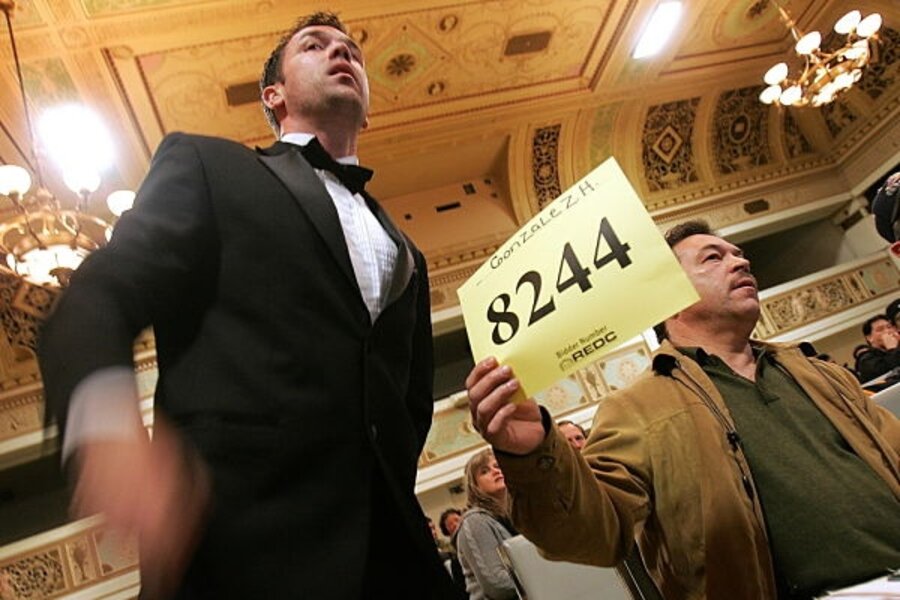Obama mortgage aid targets distressed homeowners
Loading...
| New York
President Obama is approaching America’s burgeoning foreclosure problem with a bag full of new taxpayer-financed incentives to entice lenders to make millions of mortgages more affordable for distressed homeowners.
In a much-awaited announcement, the White House said Wednesday it will use $75 billion already authorized by Congress to essentially subsidize the mortgage payments of millions of Americans whose homes are now worth less than they owe. Much of the money will go to banks to reward them for amending mortgages to make them more affordable, but homeowners will also get a financial bonus for staying current with their mortgage payments.
Money would also be used – beyond the $75 billion – to bulk up Fannie Mae and Freddie Mac, the government-owned buyers of mortgages. This would allow them to acquire more loans.
“This is not a silver bullet, although I don’t think one exists,” says Mark Zandi, chief economist at Moody’s Economy.com. “This should be helpful to stem but not stop the continuing rise in foreclosures.”
Is the plan big enough?
While the White House plan involves billions of dollars, the size of the problem is even larger. Some $500 billion in mortgages, Mr. Zandi estimates, are underwater – meaning the value of the mortgage is higher than the value of the house.
“There is no way to help all $500 billion,” he says.
In 2008, there were 3.2 million foreclosure filings, estimates RealtyTrac, which tracks and sells foreclosure data. That’s an 81 percent increase over 2007.
“Depending on who you listen to, there could be 10 million to 13 million more foreclosures in the next five to six years,” says John Taylor, president of the National Community Reinvestment Coalition, which represents some 600 community groups in Washington. “That is pretty catastrophic.”
Target: responsible homeowners
The White House initiative, called the Homeowner Affordability and Stability Plan, is aimed at homeowners who are still making their monthly payments but cannot refinance because the value of their home has fallen so much. Because many homeowners have been unable to refinance their homes, their mortgage payments, particularly as a percentage of their income, have climbed as their adjustable-rate mortgages have reset.
Such a trend has been particularly challenging as the recession has deepened and layoffs have mounted.
“In the past, if you found yourself in a situation like this, you could have sold your home and bought a smaller one with more affordable payments. Or you could have refinanced your home at a lower rate,” said Mr. Obama Wednesday in Mesa, Ariz. “But today, home values have fallen so sharply that even if you make a large down payment, the current value of your mortgage may still be higher than the current value of your house. So no bank will return your calls, and no sale will return your investment. You can't afford to leave and you can't afford to stay.”
Bank, government share losses
Under one part of the White House plan, banks will take the first step, reducing a homeowner’s monthly payment to 38 percent of the homeowner’s income. Then, the government will step in, providing a subsidy to get the monthly payment down to 31 percent of the homeowner’s income. This part of the plan is for subprime mortgages – those made to people with less-than-stellar credit.
In a fact sheet, the White House estimates that the savings for a family with $200,000 remaining on a 30-year, fixed-rate 6.5 percent mortgage would come to $2,300 annually, or about $191 a month.
As an added incentive for borrowers to keep current, the plan also will give such borrowers $1,000 a year for five years that goes toward reducing the principal balance of a loan.
The carrot for the mortgage owner or servicer is an upfront payment of $1,000 for each mortgage that is modified downward. And, if the modification is successful, the bank will get another $1,000 a year for up to three years.
Additional Treasury plan
The new housing plan follows the US Treasury’s announcement that it was working on a plan to buy underperforming loans from US financial institutions. Treasury Secretary Timothy Geithner is still hammering out the details of the plan. But the plan announced Wednesday could help that effort if it reduces the number of foreclosed properties, says Alan White, an expert on loan modifications and a professor at Valparaiso University School of Law in Valparaiso, Ind.
“These two plans are closely related,” he says.
Mr. White is generally positive about the new approach. “These are all fairly thoughtful carrots,” he says. “But it would not hurt to use the power of the US Treasury or the FDIC [Federal Deposit Insurance Corp.] to strongly encourage the servicers to participate.”
However, Mr. Taylor says his organization is disappointed. “It will provide some help for homeowners on the fringe if interest rates dropped,” he says. “But I think their estimate of the amount of folks who will be helped is optimistic.”
Will banks go along?
For example, Taylor is not certain the banks will volunteer for the program. “Are those incentives enough to lop off tens of thousands of dollars that a homeowner will owe the bank?” he asks. And, he adds, the program is only slated to run for five years, after which the loans may revert back to their original status. “It just pushes off the problem for five years,” he says.
Some other housing experts were hoping the Obama administration would require modifications of the
principal amount owed. “Say someone bought a house for $400,000, and it’s now worth $200,000. They are just walking away from the mortgage,” says Jack McCabe of McCabe Research & Consulting in Deerfield Beach, Fla. "There is no incentive to keep making payments on houses that are continuing to decline.”
The Obama plan hopes to address this problem by stabilizing home prices.





